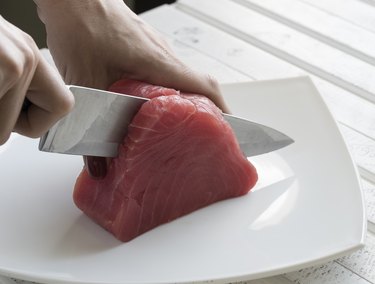
Yellowfin (ahi), tuna is firm and meaty, with deep red flesh. You'll often find it served as raw sashimi in sushi restaurants, but a yellowfin tuna steak is fabulous pan-seared, too. If you cook yellowfin tuna this way, following a few simple rules will guarantee delicious results every time.
Why Eating Tuna is Healthy
Video of the Day
Yellowfin tuna isn't just tasty, it's nutritious too. The USDA says that a 4-ounce serving of the cooked fish has just 165 calories, but provides a huge 138 micrograms of selenium, a mineral that is important for protecting against infection according to the Office of Dietary Supplements.
Video of the Day
A 4-ounce cooked yellowfin tuna steak also contains a large amount — 28.2 milligrams — of niacin or vitamin B3, which is one of the vital energy vitamins.
Cooked yellowfin is just a modest source of omega-3 fats (EPA and DHA), that most of us should be eating more of. A 4-ounce serving provides 153 milligrams, compared with the 250 milligrams average the American Heart Association (AHA) suggest we need each day. AHA advice is to consume at least two servings of fish, particularly oily types, per week, so make your second portion higher in omega-3 oils: mackerel, salmon, herring and albacore tuna fit the bill.
Seared Tuna Steak Recipe
Choosing yellowfin tuna steaks that are not too thin is important, according to Jamie Oliver. In his YouTube video "How to Cook Tuna Steak," the celebrity chef recommends using steaks that are at least three-quarters of an inch (2 centimeters) thick. These are the steps he recommends for perfectly pan-seared tuna.
- Season and oil: Use a few crushed coriander and fennel seeds along with some salt and black pepper to season both sides of the yellowfin tuna steak. Follow by massaging both sides with some olive oil.
- Add to the pan: Use a dry non stick pan heated to high so the tuna sizzles immediately on touching the metal. You can see the progression of the heat into the fish, turning it from red to greyish-brown as it cooks.
- Turn over: Turn after about 1 ½ to two minutes, at this point adding a small drizzle of oil to the pan to keep it sizzling nicely. After another 1 ½ to two minutes the yellowfin should be cooked to rare, which is what chefs recommend for the best eating quality.
- Let rest: Immediately after removing from the pan, massage in some more olive oil and squeeze some lemon juice over. Leave for one minute before serving.
Is Rare Tuna Safe?
Although eating tuna rare is the gourmet suggestion, it's not what the USDA recommends. To ensure good food safety, they say all types of fish should be cooked until the middle reaches a temperature of 145 degrees Fahrenheit.
However the Academy of Nutrition and Dietetics says that raw and undercooked seafood will usually only pose a small health risk for healthy people. Tuna is much less risky than, say, oysters, which the Food and Drug Administration warns can harbor the bacteria Vibrios vulnificus — life-threatening to vulnerable people infected with it.
In a nutshell, you're at very little risk from eating a rare yellowfin tuna steak if you're fit and healthy. But to cook yellowfin tuna to 145 degrees Fahrenheit is your golden rule if you're serving it to very young or old people, pregnant people or those with illnesses that leave them immuno-compromised.
As regards mercury, yellowfin tuna isn't a big concern. The FDA puts fresh yellowfin in the "good choice" category for mercury content and says one serving a week is fine.
- USDA: " Fish, Tuna, Yellowfin, Fresh, Cooked, Dry Heat"
- Office of Dietary Supplements: "Selenium"
- AHA: "Fish and Omega-3 Fatty Acids"
- YouTube: "How to Cook Tuna Steak | Jamie Oliver"
- USDA: "Safe Minimum Internal Temperature Chart"
- Academy of Nutrition and Dietetics: "Is Raw Seafood Safe to Eat?"
- Food and Drug Administration: "Vibrio Vulnificus Health Education Kit Fact Sheet"